Potential Challenges and Barriers to Widespread 5G Adoption
The advent of 5G technology heralds a new era of connectivity, promising faster speeds, lower latency, and more reliable connections. However, despite the immense potential of 5G, its widespread adoption faces numerous challenges and barriers. From infrastructure issues to regulatory concerns, and from economic implications to public perception, the road to 5G ubiquity is complex and fraught with obstacles. This article delves into the key challenges that may hinder the widespread adoption of 5G technology.
1. High Infrastructure Costs
One of the most significant barriers to 5G adoption is the high cost of infrastructure development. 5G networks require a dense deployment of small cells, antennas, and other equipment to achieve the promised high-speed and low-latency connections. Unlike previous generations of wireless technology, which relied on large cell towers, 5G necessitates a vast network of smaller, closer-spaced cells. This densification is expensive and time-consuming, requiring significant investments from telecom operators.
Building a comprehensive 5G network involves not only the installation of new equipment but also the upgrading of existing infrastructure to support higher data rates and more connected devices. The cost of these upgrades can be prohibitive, particularly in rural and less densely populated areas where the return on investment may be lower. Consequently, telecom operators may prioritize urban centres, leading to a digital divide where rural areas are left behind in the 5G revolution.
Driving into the Future: How 5G is Revolutionizing Autonomous Vehicles
2. Spectrum Availability and Management
Another critical challenge in the deployment of 5G networks is the availability and management of spectrum. 5G technology operates on a range of frequencies, including low-band, mid-band, and high-band (millimeter-wave) spectrums. Each of these bands has its advantages and limitations, and their allocation and management are crucial to the success of 5G.
The high-band spectrum offers the fastest speeds but has limited range and penetration capabilities, requiring a denser network of cells. On the other hand, the low-band spectrum provides broader coverage but at slower speeds. Mid-band spectrum strikes a balance between speed and coverage but is often already in use for other purposes, such as military or satellite communications.
Governments and regulatory bodies need to allocate sufficient spectrum for 5G use, which can be a complex and politically sensitive process. Auctions for spectrum licenses can be expensive, and the competition among telecom operators for these licenses can drive up costs, further complicating the deployment of 5G networks.
3. Regulatory and Policy Challenges
The rollout of 5G networks is subject to various regulatory and policy challenges that can slow down adoption. These challenges can vary significantly from one country to another, depending on local laws, regulations, and political climates.
In some countries, the approval process for new infrastructure can be slow and cumbersome, with multiple layers of bureaucracy involved in obtaining permits and licenses. Local governments may have concerns about the aesthetic impact of small cell installations or the potential health effects of increased electromagnetic radiation, leading to delays or outright bans on new infrastructure.

Internationally, the geopolitical landscape also plays a role in 5G adoption. For example, concerns about the security of 5G networks supplied by certain vendors have led to restrictions or bans on the use of their equipment in some countries. This has created tensions between nations and could lead to the fragmentation of 5G standards and networks, complicating global interoperability.
4. Economic and Financial Barriers
The economic and financial implications of 5G adoption are another major barrier to its widespread rollout. The costs associated with building and maintaining 5G networks are substantial, and telecom operators may struggle to recoup these investments, particularly in the early stages of deployment.
The business case for 5G is still being developed, and it remains unclear how quickly operators will be able to generate revenue from 5G services. While 5G offers the potential for new revenue streams through services like IoT, smart cities, and autonomous vehicles, these markets are still in their infancy, and the demand for 5G-enabled services may take time to materialize.
Additionally, the high cost of 5G-compatible devices could slow down consumer adoption. While the price of 5G smartphones has been gradually decreasing, they are still more expensive than their 4G counterparts. This price premium may deter consumers, particularly in price-sensitive markets, from upgrading to 5G.
5. Technological Challenges and Compatibility Issues
5G technology introduces a range of new technical challenges that need to be addressed for widespread adoption. One of the primary challenges is ensuring backward compatibility with existing 4G networks. As 5G is rolled out, it will need to coexist with 4G for many years, requiring seamless handovers between the two technologies. Achieving this level of integration is technically complex and requires significant coordination between different network elements.
Another technological challenge is the development of 5G-specific applications and services. While 5G promises to enable new use cases like augmented reality (AR), virtual reality (VR), and massive IoT deployments, these applications require robust and mature ecosystems. The development of these ecosystems is still in progress, and it may take several years before 5G-specific services are widely available.
Moreover, 5G networks require advanced security measures to protect against new types of cyber threats. As more devices become connected through 5G, the attack surface for cybercriminals expands, necessitating stronger and more sophisticated security protocols. The implementation of these security measures adds another layer of complexity to 5G deployment.
6. Health and Environmental Concerns
Public concern about the potential health effects of 5G radiation is a significant barrier to its widespread adoption. Although numerous studies have shown that the radiation levels from 5G networks are well within the safety limits set by international health organizations, public perception remains a challenge.
Misinformation and conspiracy theories about the health risks of 5G, such as claims that it causes cancer or weakens the immune system, have gained traction in some communities. This has led to protests and opposition to the installation of 5G infrastructure in certain areas, further delaying deployment.
Environmental concerns also play a role in the resistance to 5G adoption. The densification of networks required for 5G involves the installation of many small cells and antennas, which some environmental groups argue could hurt the environment. Additionally, the increased energy consumption of 5G networks is a concern, particularly in the context of global efforts to reduce carbon emissions.
7. Consumer Awareness and Adoption
Consumer awareness and understanding of 5G technology are crucial for its widespread adoption. However, many consumers are still unaware of the benefits of 5G or do not see a compelling reason to upgrade from 4G. This lack of awareness can slow down the uptake of 5G devices and services, particularly if consumers perceive the benefits of 5G as incremental rather than revolutionary.
Moreover, the marketing of 5G has been inconsistent, with some operators overhyping the capabilities of the technology, leading to unrealistic expectations among consumers. When the experience of 5G does not match these expectations, it can result in disappointment and reluctance to adopt the technology.
Education and outreach efforts are needed to inform consumers about the real benefits of 5G, such as improved video streaming, faster downloads, and the potential for new applications. However, these efforts take time and resources, and overcoming consumer scepticism may be a slow process.
8. Privacy and Security Concerns
The increased connectivity and data generation enabled by 5G raise significant privacy and security concerns. As more devices become interconnected through 5G, the volume of data being transmitted and collected increases exponentially. This data can include sensitive personal information, location data, and other types of data that, if not properly secured, could be vulnerable to cyberattacks.
The potential for mass surveillance is also a concern with 5G. The ability to connect billions of devices in real time creates opportunities for more comprehensive tracking and monitoring of individuals and their activities. Governments and private companies could potentially use this capability for surveillance purposes, raising ethical and privacy issues.
To address these concerns, strong privacy and data protection regulations will be necessary. However, the implementation of such regulations is challenging and requires international cooperation. The lack of a global consensus on privacy standards could lead to fragmented policies and uneven levels of protection for consumers.
9. Digital Divide and Inequality
The deployment of 5G networks has the potential to exacerbate the digital divide, particularly between urban and rural areas, as well as between developed and developing countries. In urban areas, where the population density is high, the business case for 5G is stronger, and telecom operators are more likely to invest in the necessary infrastructure. However, in rural areas with lower population densities, the return on investment may not justify the high costs of 5G deployment.

As a result, rural communities may be left behind, with limited or no access to 5G services. This could widen the digital divide, creating disparities in access to the economic, educational, and social opportunities that 5G enables.
Similarly, developing countries may struggle to keep up with the pace of 5G deployment in developed nations. The high costs of infrastructure, coupled with economic constraints, could delay or prevent the rollout of 5G in these regions, further entrenching global inequalities in access to technology.
10. Supply Chain and Geopolitical Risks
The global supply chain for 5G equipment is complex and heavily influenced by geopolitical factors. The production of 5G equipment involves multiple countries, with different components being manufactured in various parts of the world. Any disruption in this supply chain, whether due to trade disputes, sanctions, or other geopolitical issues, can impact the deployment of 5G networks.
For example, the ongoing trade tensions between the United States and China have had significant implications for the 5G supply chain. The restrictions on Chinese telecom equipment manufacturers have forced some countries to seek alternative suppliers, which can lead to delays and increased costs in the rollout of 5G networks.
Geopolitical risks also extend to concerns about the security and reliability of 5G equipment from certain vendors. Some countries have raised concerns that equipment from specific manufacturers could be used for espionage or other malicious activities, leading to bans or restrictions on the use of such equipment. These geopolitical tensions could lead to a fragmented global 5G ecosystem, with different regions adopting different standards and technologies.
11. Interoperability and Standards Fragmentation
The success of 5G relies heavily on the interoperability of networks and devices across different regions and manufacturers. However, the development of global standards for 5G has been a complex process, with multiple stakeholders involved, including telecom operators, equipment manufacturers, and regulatory bodies.
Implementing 5G in Smart Cities: Transforming Urban Landscapes
The risk of standards fragmentation is a significant challenge for 5G adoption. If different regions adopt different technical standards for 5G, it could lead to compatibility issues between networks and devices, limiting the ability of users to roam globally and access services across different networks. This fragmentation could also hinder the development of a global ecosystem of 5G applications and services, reducing the overall potential of the technology.
12. Uncertain Return on Investment (ROI) for Telecom Operators
One of the significant challenges for telecom operators is the uncertainty surrounding the return on investment (ROI) for 5G. While 5G promises to enable new revenue streams through enhanced mobile broadband, IoT, and other services, the timing and scale of these revenue opportunities are still uncertain.
Operators must make substantial upfront investments in infrastructure, spectrum acquisition, and network upgrades, with the expectation that these investments will pay off in the long term. However, the competitive landscape, regulatory pressures, and market dynamics could impact the profitability of 5G services, making it challenging for operators to achieve their desired ROI.
Moreover, the monetization of 5G services is still evolving, and it remains unclear how quickly consumers and businesses will be willing to pay for premium 5G offerings. If the revenue generation from 5G is slower than anticipated, operators may struggle to justify the high costs of deployment, potentially delaying or scaling back their investment in 5G networks.
While 5G technology holds tremendous potential to revolutionize industries, enhance connectivity, and enable new applications, its widespread adoption faces numerous challenges and barriers. From the high costs of infrastructure development to regulatory hurdles, technological complexities, and public concerns, the road to 5G ubiquity is fraught with obstacles.
Addressing these challenges will require coordinated efforts from governments, telecom operators, equipment manufacturers, and other stakeholders. Effective policy frameworks, international cooperation, and public education will be essential to overcoming the barriers to 5G adoption and ensuring that the benefits of this transformative technology are realized on a global scale.
In the coming years, as 5G networks continue to roll out, it will be crucial to monitor and address these challenges to ensure that 5G fulfils its promise of ushering in a new era of connectivity and innovation.





Post Comment